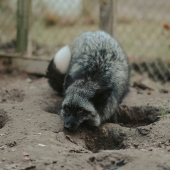SILVER FOXES
Class: Mammalia
Order: Carnivora
Family: Canidae
Species: Vulpes vulpes (Red fox)
Status: Least Concern

The silver fox is a melanistic form of the red fox. They may represent about 10% of the red fox population. The silver fox’s coloration can range from black to bluish gray to silver with a white-tipped tail. Silver hairs may be widely scattered all over their body. Their pelt is prized in the fur industry and thus, they are raised on farms for fur production. They have a thick dark undercoat with an outer coat which may be 2 inches longer than the undercoat. Their fur is soft and glossy and the soles of their feet are thickly coated.
LIFE SPAN
Red foxes have a lifespan of 3 years in the wild and 10 to 12 years in captivity.
DIET
Silver foxes are opportunistic hunters and eaters. They prefer a carnivorous diet but can rely on plant material when meat is scarce. In the wild, they use different strategies to hunt different prey. When they hunt small animals, they rely on sound to locate the prey and then spring up to pin the victim to the ground and kill by biting it. For larger ground prey, they rely on stalking and rapid pursuit. Catty Shack’s silver fox eats 3-5 pounds of food 5 or 6 nights a week. The Catty Shack Ranch follows the USDA guidelines and feeds according to their body weight. They also follow strict nutrition requirements from their veterinarians and also add vitamins and minerals to all their food.
SIZE
Red foxes may range from 17 to 35 inches long (head and body) with a tail from 12 to 22 inches long. They may weigh 6 to over 20 pounds. Females are usually smaller than males.
HABITAT & NUMBERS
Silver foxes may be found over much of the northern hemisphere and even in Australia. Humans introduced them to many habitats for hunting purposes. In North America, they are found mostly in the Northwest although historically they were trapped in the East. In Russia, they are found predominantly in Siberia and in the Caucasus mountain region.
REPRODUCTION
In the wild, silver foxes do not necessarily mate only with similar colored individuals. They can mate with other red foxes or individuals who are silver/red mixes. In captivity, they are bred to others of the same color. Silver foxes reach sexual maturity by 10 months of age. Mating occurs once a year, usually in January and February. Males and females are generally seasonally monogamous during the mating season. Gestation is about 52 days and litters can range from 1 to 14 pups, averaging 3 to 6 pups. Larger litters occur when the mother is more mature and when food is abundant. The male will help provide food for the mother and pups and helps protect the den. Unmated females will also help raise a large litter. The pups venture outside the den at 4 to 5 weeks of age and are weaned by 8 to 10 weeks of age. They remain with their mother until their first autumn.
OTHER FUN SILVER FOX FACTS
Silver foxes use scent marking as a social record, for communication and to display dominance.An extensive long-term experiment on domestication of silver foxes has been carried out in Russia. Starting in the 1950’s through selective breeding for tameness, successive generations of silver foxes became tamer and more dog-like. They are more friendly to humans (even seeking attention), wag their tails when happy and vocalize and bark like dogs. Their coats have also developed patterns including spots like dogs, their ears have become floppier and they have lost their distinctive musky fox smell.

